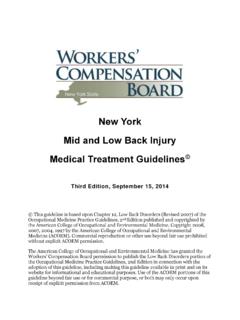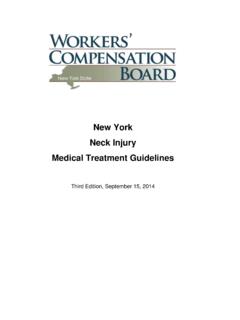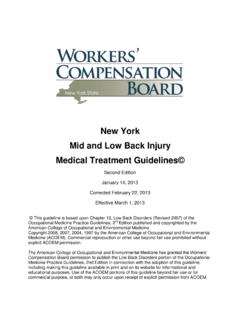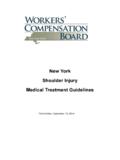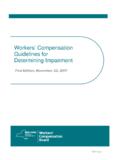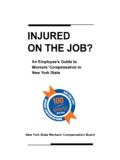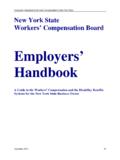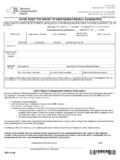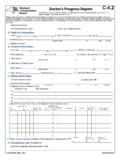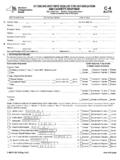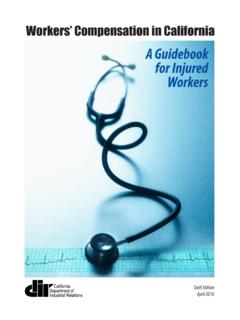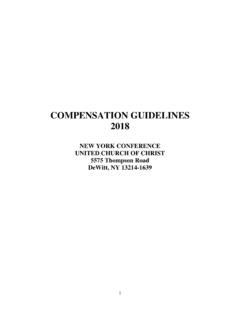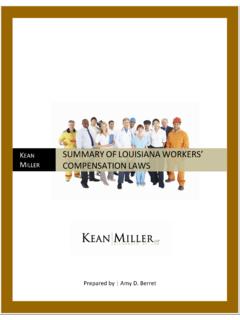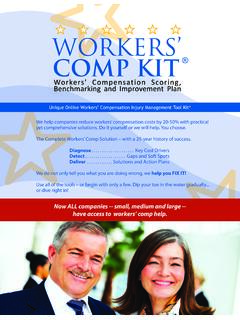Transcription of STATE OF NEW YORK - NYS Workers …
1 STATE OF NEW york Workers ' compensation BOARD MEDICAL guidelines June 1996 David A. Paterson, Governor Robert E. Beloten, Chair TABLE OF CONTENTS FOREWORD .. vii INTRODUCTION .. 1 A. ROLE OF EXAMINING HEALTH 2 B. ROLE OF THE Workers ' compensation LAW JUDGE .. 2 C. DISABILITY EVALUATION IN Workers ' compensation CASES.. 2 Review of the Claimant's 3 1. TYPES OF DISABILITY UNDER THE Workers ' compensation LAW .. 3 2. TYPES OF FINAL EVALUATION EXAMINATION .. 3 Schedule Awards .. 4 Non-Schedule I. EXTREMITIES .. 6 A. UPPER 1. THUMB .. 6 2. 8 Special 8 3 . BONE LOSS .. 9 4. LOADING .. 9 5. AMPUTATIONS ..10 6. DUPUYTREN' S CONTRACTURE .. 10 7. WRIST .. 11 Special Considerations .. 12 ii 8. ELBOW .. 13 Special Considerations.
2 14 9. SHOULDER JOINT .. 14 Special Considerations .. 15 B. LOWER EXTREMITY .. 16 1. HIP .. 16 Special Considerations.. 16 2. 17 Special Considerations.. 18 3. ANKLE AND FOOT.. 19 Special Considerations .. 21 4. GREAT TOE .. 21 Amputations .. 21 Defects of Mobility .. 21 5. SMALLER TOES (SECOND, THIRD, FOURTH & FIFTH) .. 22 Special Considerations (Loading) .. 22 II. LOW 23 A. EXAMINATION PROCESS .. 23 1. 23 2. PRESENT COMPLAINT .. 23 3. PHYSICAL EXAMINATION .. 23 B. DIAGNOSTIC PROCEDURES AND SPECIALIZED 25 C. DIAGNOSTIC FINDINGS.. 25 D. OTHER IMPORTANT POSITIVE LABORATORY FINDINGS .. 25 E. MODALITIES OF TREATMENT.. 25 iii F. CRITERIA THAT MAY BE USED FOR EVALUATION OF DEGREE OF PARTIAL DISABILITY ..26 Moderate ..26 Marked ..27 G. DETERMINATION OF TOTAL H. FINAL ASSESSMENT OF LOW BACK EXAMINATION ..27 I. CONCLUSION OF CAUSALLY RELATED SPINAL INJURIES (NECK AND LOW BACK)..28 III. CERVICAL SPINE INJURIES DUE TO A.
3 PATHOPHYSIOLOGY ..29 B. EXAMINATION 1. HISTORY ..30 2. PRESENT COMPLAINT ..30 3. PHYSICAL EXAMINATION ..30 C. DIAGNOSTIC TESTING AND INTERPRETATION OF FINDINGS ..30 D. TREATMENT..31 E. FINAL ASSESSMENT OF DISABILITY OF THE CERVICAL SPINE ..31 IV. NERVOUS CENTRAL NERVOUS SYSTEM ..32 A. CRANIOCEREBRAL B. C. CRANIAL NERVES ..33 1. First Nerve ..33 , Fourth, & Sixth 3. Fifth Nerve ..33 4. Seventh 5. Eighth Nerve ..33 6. Ninth, Tenth and Eleventh Nerve ..33 7. Twelfth Nerve ..33 D. MOTOR SYSTEM 1. 2. Spinal Cord ..34 E. SENSORY DEFECTS ..35 F. CONCLUSIONS ..35 G. PLEXOPATHIES ..36 H. THORACIC OUTLET SYNDROME ..37 I. ENTRAPMENT J. MEDIAN NERVE - (CARPAL TUNNEL SYNDROME) ..37 K. ULNAR - (CUBITAL TUNNEL SYNDROME) ..38 1. Elbow ..38 2. L. ANTERIOR INTEROSSEOUS (PRONATOR TERES SYNDROME) ..38 L. (A) POSTERIOR M. LATERAL FEMORAL CUTANEOUS NERVE (MERALGIA PARESTHETICA).
4 39 N. TARSAL TUNNEL SYNDROME (POSTERIOR TIBIAL ENTRAPMENT) ..40 O. PLANTAR (MORTON'S METATARSALGIA) ..40 P. COMPLICATIONS OF PLEXUS AND PERIPHERAL NERVE INJURY ..40 Q. CAUSALGIA ..40 V. LESS COMMON WORK RELATED CONDITIONS AND A. MEDICAL iv 1. WORK RELATED DERMATITIS ..42 2. CAUSALLY RELATED INFECTIOUS DISEASES ..42 3. WORK RELATED POST TRAUMATIC NEUROSIS; POST TRAUMATIC STRESS DISORDER AND OTHER CAUSALLY RELATED PSYCHIATRIC CONDITIONS ..42 B. SURGICAL DISORDERS ..42 1. HERNIA ..42 2. CAUSALLY RELATED SURGICAL EXCISION OF VITAL 3. FACIAL SCARS AND VI. RESPIRATORY DISEASES, CARDIOVASCULAR DISEASES AND VASCULAR DISEASES OF THE EXTREMITIES ..44 A. EVALUATION PROCESS ..44 B. RESPIRATORY DISEASES ..45 1. HISTORY ..45 2. CLINICAL EVALUATION ..45 3. PHYSICAL 4. DIAGNOSTIC TESTING ..45 5. CRITERIA FOR EVALUATING DEGREE OF DISABILITY AS RELATED TO RESPIRATORY DISEASES ..46 Permanent Partial Permanent Total C.
5 CARDIOVASCULAR DISEASES ..47 1. MEDICAL EVALUATION OF CARDIOVASCULAR CASES ..47 v vi 2. EVALUATION CRITERIA FOR CARDIOVASCULAR DISEASES ..48 Permanent Partial Moderate ..48 Marked ..48 Permanent Total Disability ..49 D. VASCULAR DISEASES OF THE EXTREMITIES ..49 VII. VISUAL A. CRITERIA AND METHODS FOR EVALUATING PERMANENT IMPAIRMENT ..50 1. CENTRAL VISUAL ACUITY ..50 2. VISUAL FIELDS ..51 3. DETERMINING LOSS OF VISUAL FIELD ..51 4. DETERMINING SCHEDULE FOR DIPLOPIA ..52 VIII. LOSS OF HEARING ..53 A. OCCUPATIONAL LOSS OF HEARING ..53 B. TRAUMATIC LOSS OF HEARING ..53 APPENDIX I - REFERENCES ..54 APPENDIX II - Table of Weeks by Percentage Loss of Use of Body vii FOREWORD In 1983, the New york STATE Legislature established a Temporary STATE Commission on Workers ' compensation and Disability Benefits to study and evaluate the systems of the New york STATE Workers ' compensation Board. Appointments to the twelve-member Commission in 1984 included representatives of organized labor, the insurance industry, the business community and the public-at-large.
6 In addition, the Commissioner of Labor, the Superintendent of Insurance, and the Chair of the Workers ' compensation Board were designated as ex officio members. In 1986, the Commission issued its final recommendations, among which was the establishment of published uniform medical guidelines for the evaluation of functional impairments. Such guidelines would be available to the public in general, and to medical and legal practitioners in particular. The utilization of guidelines should result in a more uniform evaluation process and greater consistency among providers in making functional impairment determinations, ultimately leading to a lesser amount of litigation with regard to such evaluations. In order to meet this mandate, a committee was formed, co-chaired by the Workers ' compensation Board Medical Director and the Director of Regulatory Services, including representatives of the medical profession and insurance industry.
7 Utilizing all available sources of information, including the American Medical Association's guides of the Evaluation of Permanent Impairment, the committee produced the document which follows. These guidelines are effective immediately. viii 1 INTRODUCTION Prior to the creation of the current New york STATE Workers ' compensation system, when a worker was injured, the only remedy was to sue in a court of law. In these instances the employer usually raised one of three objections -- that the worker had assumed the risk of employment, that the injury was caused by the worker 's negligence, or that the injury was caused by the negligence of a fellow worker . In addition, because of crowded court calendars, years frequently passed before a decision was rendered. Consequently, it was quite difficult for injured Workers to receive adequate and timely compensation for their injuries. In 1909, the New york STATE Legislature created the Wainwright Commission to "inquire into the working of a law in the STATE of New york relative to the liability of employer to employees for industrial to the causes of accidents to employees.
8 " The Commission proposed legislation fixing liability upon an employer regardless of fault or negligence. The Legislature enacted these proposals in 1910, but the compulsory aspect of the law was declared unconstitutional by the New york Court of Appeals. However, due in part to the fire at the Triangle Shirtwaist Company in New york City in March, 1911, which killed 146 factory Workers , the Legislature proposed, and the voters adopted, a constitutional amendment permitting the enactment of a compulsory Workers ' compensation statute. Enacted in 1914, the New york STATE Workers ' compensation Act provides the basis for today's Workers ' compensation system, whereby an injured employee is entitled to all medical care and prompt payment of compensation for lost wages, if the injury arose out of and in the course of employment. The intent is to permit an injured employee to receive wage replacement and complete payment of medical bills without being required to prove which party was at fault.
9 Weekly indemnity benefits are determined by several factors including the degree of impairment. The degree of impairment is based on medical evidence presented at a Workers ' compensation hearing by various parties of interest. It is expected that the development of a body of information providing guidelines to the evaluation of both work-related injuries and illnesses leading ultimately to a recommendation as to the degree of disability, will provide for greater equity for all parties as well as expedite the review process. The medical guidelines which follow were developed in accordance with a recommendation of the Temporary STATE Commission on Workers ' compensation . It is hoped that they will serve as a convenient reference source for evaluating work-related injuries, and introduce clarity and regularity into the determination of disability. 2 A. ROLE OF EXAMINING HEALTH PROVIDERS Health providers are obligated to provide the Board and the parties their best professional opinion based upon the guidelines herein in evaluating the medical condition and the disability, if any, of the compensation claimant.
10 It is the responsibility of the health provider to submit medical evidence which the Workers ' compensation Law Judge will consider in making a legal determination about disability. When the health provider wishes to comment on non-medical factors such as age, occupation, education, etc., an explanation must be given as to the impact of these factors on the overall evaluation of the medical condition. The impact of such extrinsic factors should generally not be used in determining disability, but should be taken into account by the health provider in making a recommendation as to whether a claimant can perform within his or her regular course of employment and what medical limitations exist. The health provider should provide information as to what the claimant can do, and for how long in a given period, whether public transportation can be taken and any other relevant factors affecting the health provider's opinion as to the nature and degree of disability. B. ROLE OF THE Workers ' compensation LAW JUDGE The Workers ' compensation Law Judges have the responsibility of deciding, subject to Board review, all of the legal and factual issues which are raised before the New york STATE Workers ' compensation Board.
